Prifysgol Bangor: ASB4115 Management Research Report
VerifiedAdded on 2022/08/15
|13
|3070
|11
Report
AI Summary
This management research report, prepared for ASB4115 at Bangor University, comprehensively addresses key aspects of management research. The report begins by defining and explaining the process of a systematic review of academic literature, emphasizing its role in synthesizing existing knowledge and identifying research gaps. It then delves into various qualitative research strategies, such as participant observation, focus groups, and in-depth interviews, illustrating their application in business and management research. The report further compares and contrasts different types of mixed methods research, including triangulation design, highlighting their strengths in providing a more nuanced understanding of complex management issues. The structure includes an introduction, three main body parts, and a conclusion, providing a well-organized and in-depth analysis of the subject matter.
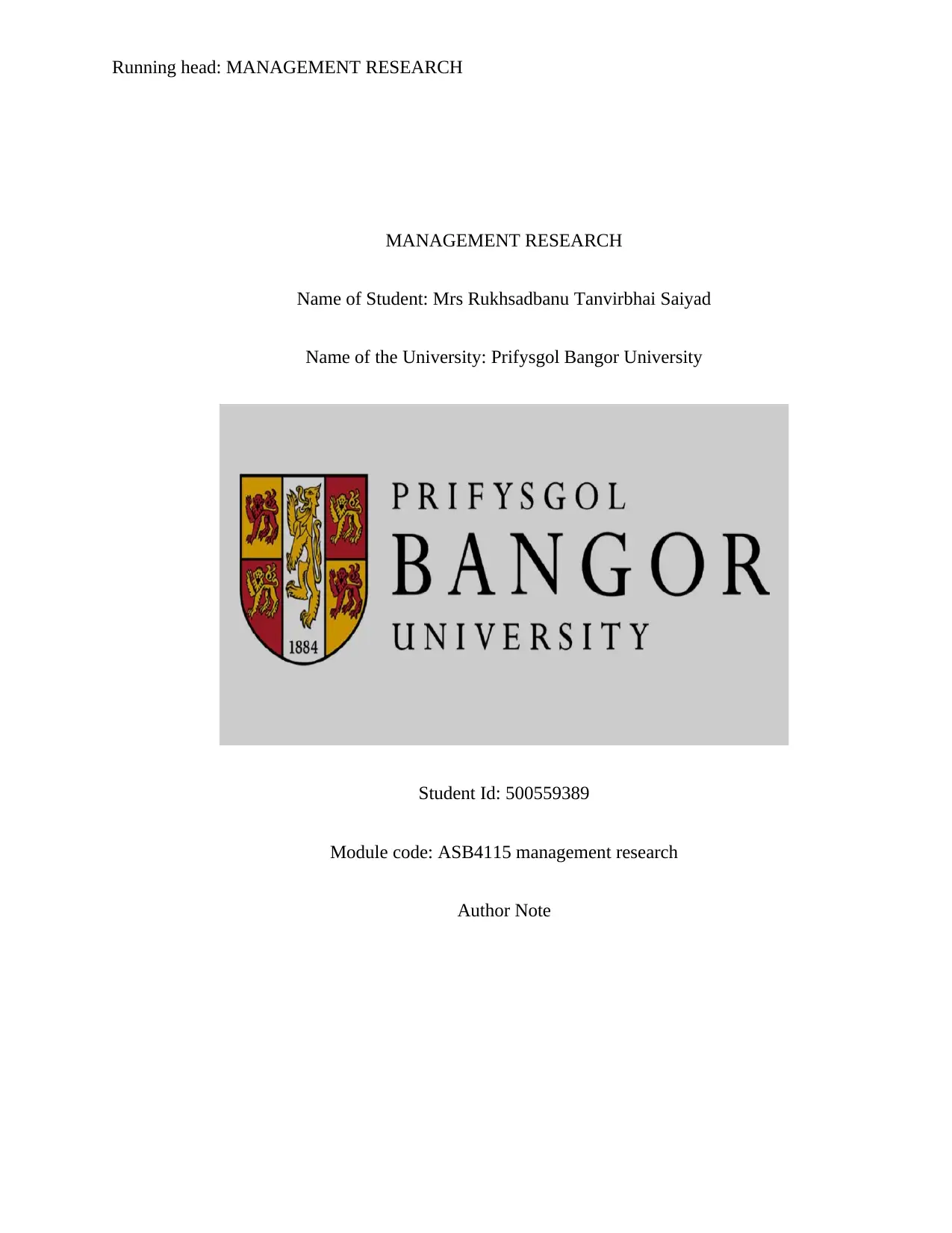
Running head: MANAGEMENT RESEARCH
MANAGEMENT RESEARCH
Name of Student: Mrs Rukhsadbanu Tanvirbhai Saiyad
Name of the University: Prifysgol Bangor University
Student Id: 500559389
Module code: ASB4115 management research
Author Note
MANAGEMENT RESEARCH
Name of Student: Mrs Rukhsadbanu Tanvirbhai Saiyad
Name of the University: Prifysgol Bangor University
Student Id: 500559389
Module code: ASB4115 management research
Author Note
Paraphrase This Document
Need a fresh take? Get an instant paraphrase of this document with our AI Paraphraser
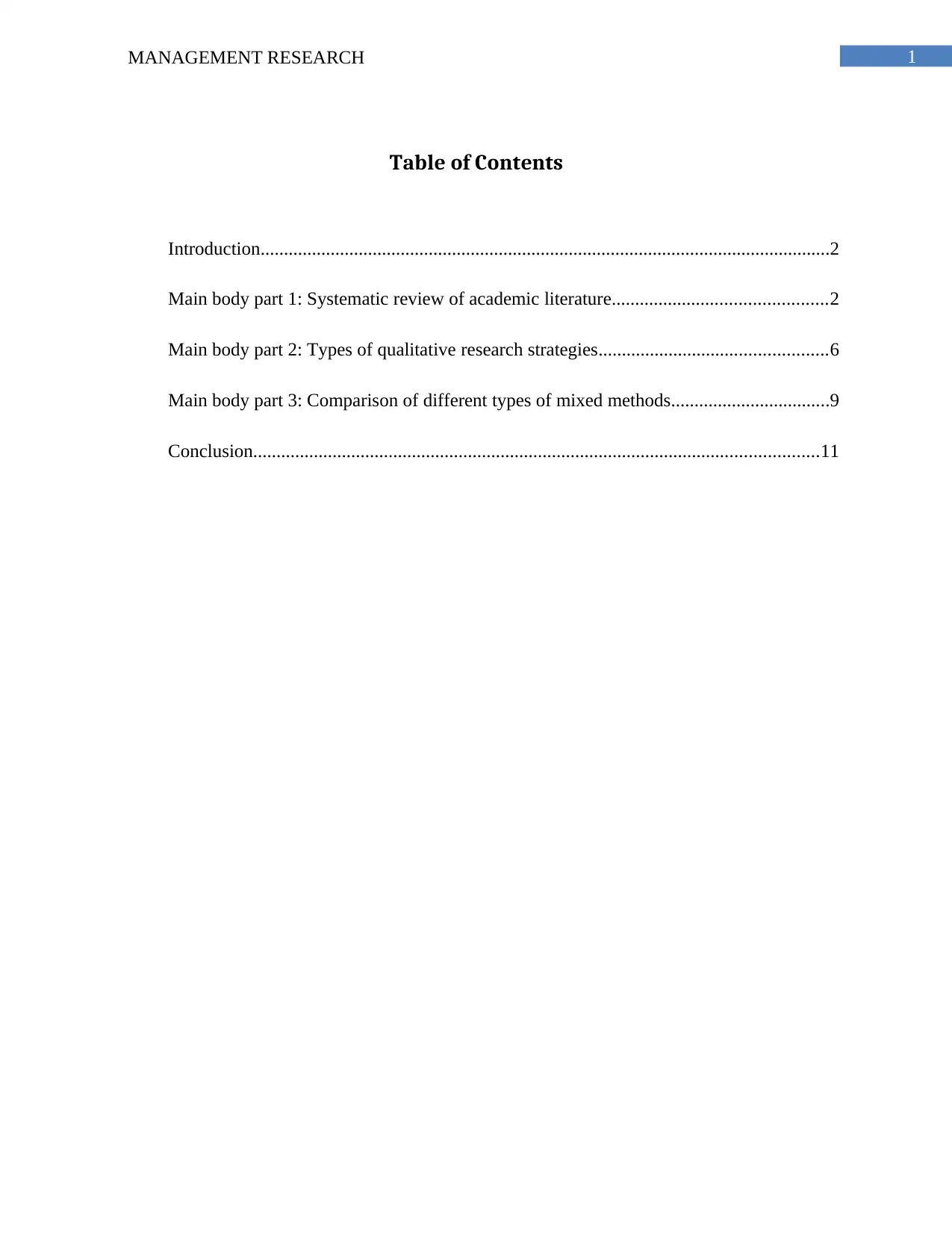
1MANAGEMENT RESEARCH
Table of Contents
Introduction..........................................................................................................................2
Main body part 1: Systematic review of academic literature..............................................2
Main body part 2: Types of qualitative research strategies.................................................6
Main body part 3: Comparison of different types of mixed methods..................................9
Conclusion.........................................................................................................................11
Table of Contents
Introduction..........................................................................................................................2
Main body part 1: Systematic review of academic literature..............................................2
Main body part 2: Types of qualitative research strategies.................................................6
Main body part 3: Comparison of different types of mixed methods..................................9
Conclusion.........................................................................................................................11
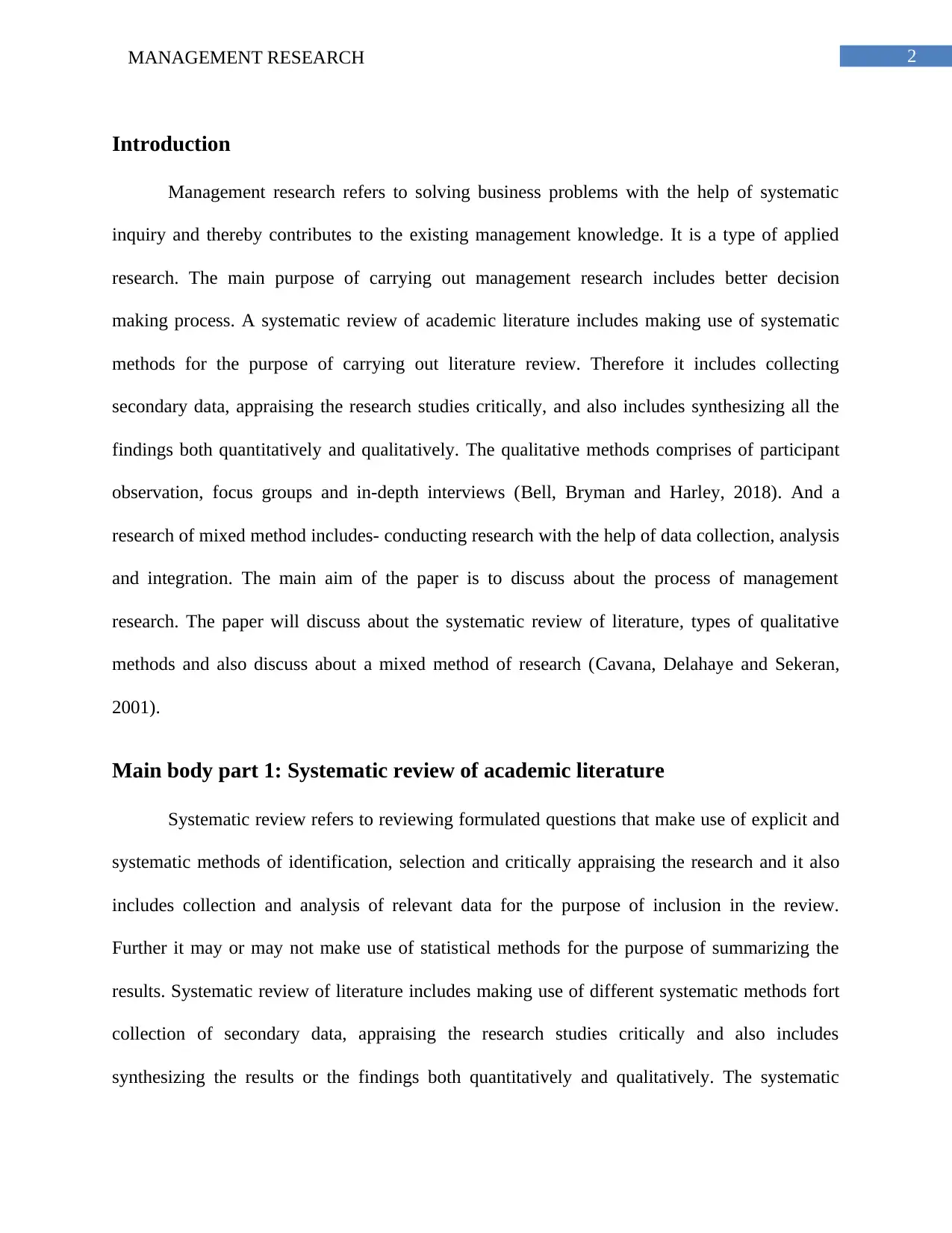
2MANAGEMENT RESEARCH
Introduction
Management research refers to solving business problems with the help of systematic
inquiry and thereby contributes to the existing management knowledge. It is a type of applied
research. The main purpose of carrying out management research includes better decision
making process. A systematic review of academic literature includes making use of systematic
methods for the purpose of carrying out literature review. Therefore it includes collecting
secondary data, appraising the research studies critically, and also includes synthesizing all the
findings both quantitatively and qualitatively. The qualitative methods comprises of participant
observation, focus groups and in-depth interviews (Bell, Bryman and Harley, 2018). And a
research of mixed method includes- conducting research with the help of data collection, analysis
and integration. The main aim of the paper is to discuss about the process of management
research. The paper will discuss about the systematic review of literature, types of qualitative
methods and also discuss about a mixed method of research (Cavana, Delahaye and Sekeran,
2001).
Main body part 1: Systematic review of academic literature
Systematic review refers to reviewing formulated questions that make use of explicit and
systematic methods of identification, selection and critically appraising the research and it also
includes collection and analysis of relevant data for the purpose of inclusion in the review.
Further it may or may not make use of statistical methods for the purpose of summarizing the
results. Systematic review of literature includes making use of different systematic methods fort
collection of secondary data, appraising the research studies critically and also includes
synthesizing the results or the findings both quantitatively and qualitatively. The systematic
Introduction
Management research refers to solving business problems with the help of systematic
inquiry and thereby contributes to the existing management knowledge. It is a type of applied
research. The main purpose of carrying out management research includes better decision
making process. A systematic review of academic literature includes making use of systematic
methods for the purpose of carrying out literature review. Therefore it includes collecting
secondary data, appraising the research studies critically, and also includes synthesizing all the
findings both quantitatively and qualitatively. The qualitative methods comprises of participant
observation, focus groups and in-depth interviews (Bell, Bryman and Harley, 2018). And a
research of mixed method includes- conducting research with the help of data collection, analysis
and integration. The main aim of the paper is to discuss about the process of management
research. The paper will discuss about the systematic review of literature, types of qualitative
methods and also discuss about a mixed method of research (Cavana, Delahaye and Sekeran,
2001).
Main body part 1: Systematic review of academic literature
Systematic review refers to reviewing formulated questions that make use of explicit and
systematic methods of identification, selection and critically appraising the research and it also
includes collection and analysis of relevant data for the purpose of inclusion in the review.
Further it may or may not make use of statistical methods for the purpose of summarizing the
results. Systematic review of literature includes making use of different systematic methods fort
collection of secondary data, appraising the research studies critically and also includes
synthesizing the results or the findings both quantitatively and qualitatively. The systematic
⊘ This is a preview!⊘
Do you want full access?
Subscribe today to unlock all pages.

Trusted by 1+ million students worldwide
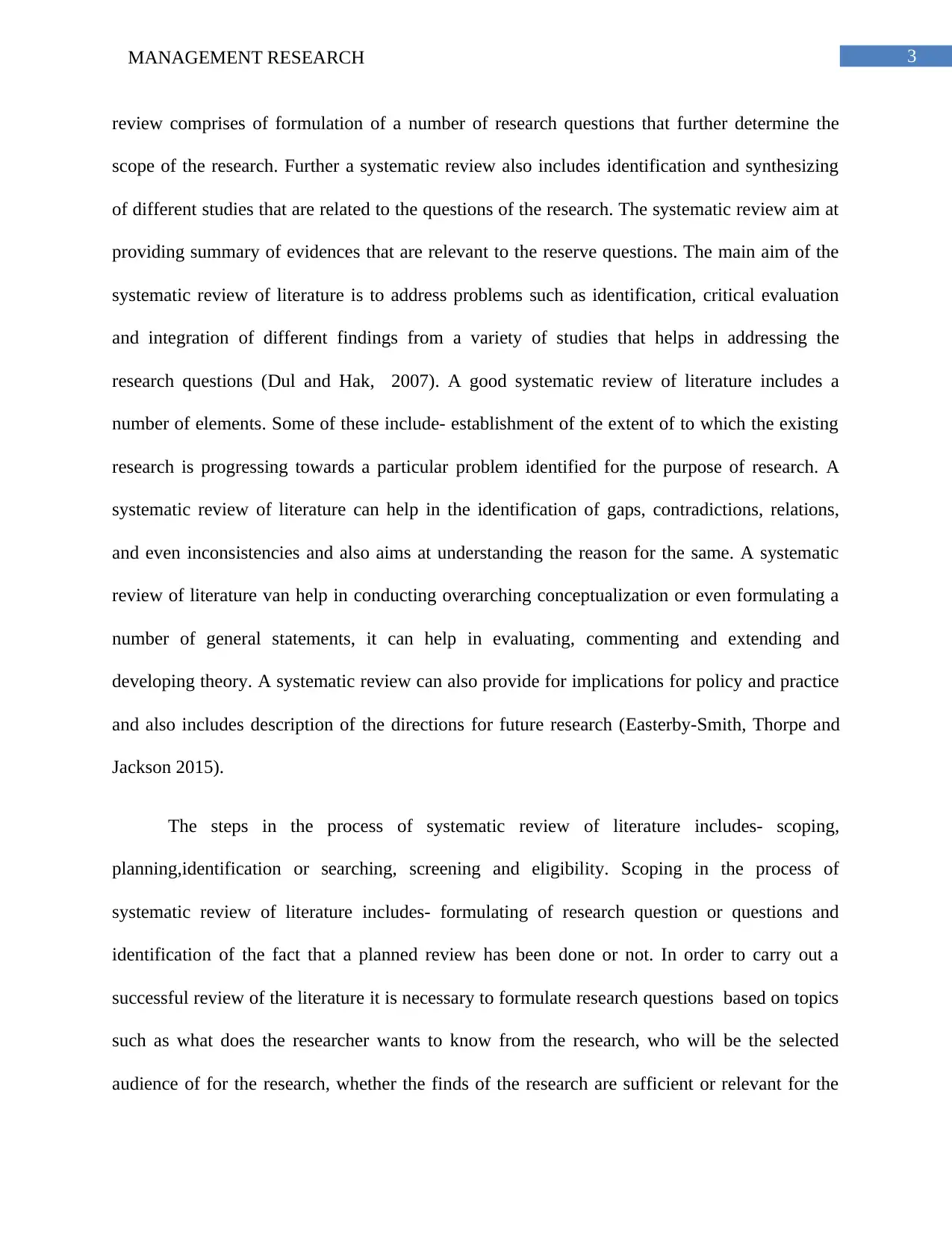
3MANAGEMENT RESEARCH
review comprises of formulation of a number of research questions that further determine the
scope of the research. Further a systematic review also includes identification and synthesizing
of different studies that are related to the questions of the research. The systematic review aim at
providing summary of evidences that are relevant to the reserve questions. The main aim of the
systematic review of literature is to address problems such as identification, critical evaluation
and integration of different findings from a variety of studies that helps in addressing the
research questions (Dul and Hak, 2007). A good systematic review of literature includes a
number of elements. Some of these include- establishment of the extent of to which the existing
research is progressing towards a particular problem identified for the purpose of research. A
systematic review of literature can help in the identification of gaps, contradictions, relations,
and even inconsistencies and also aims at understanding the reason for the same. A systematic
review of literature van help in conducting overarching conceptualization or even formulating a
number of general statements, it can help in evaluating, commenting and extending and
developing theory. A systematic review can also provide for implications for policy and practice
and also includes description of the directions for future research (Easterby-Smith, Thorpe and
Jackson 2015).
The steps in the process of systematic review of literature includes- scoping,
planning,identification or searching, screening and eligibility. Scoping in the process of
systematic review of literature includes- formulating of research question or questions and
identification of the fact that a planned review has been done or not. In order to carry out a
successful review of the literature it is necessary to formulate research questions based on topics
such as what does the researcher wants to know from the research, who will be the selected
audience of for the research, whether the finds of the research are sufficient or relevant for the
review comprises of formulation of a number of research questions that further determine the
scope of the research. Further a systematic review also includes identification and synthesizing
of different studies that are related to the questions of the research. The systematic review aim at
providing summary of evidences that are relevant to the reserve questions. The main aim of the
systematic review of literature is to address problems such as identification, critical evaluation
and integration of different findings from a variety of studies that helps in addressing the
research questions (Dul and Hak, 2007). A good systematic review of literature includes a
number of elements. Some of these include- establishment of the extent of to which the existing
research is progressing towards a particular problem identified for the purpose of research. A
systematic review of literature can help in the identification of gaps, contradictions, relations,
and even inconsistencies and also aims at understanding the reason for the same. A systematic
review of literature van help in conducting overarching conceptualization or even formulating a
number of general statements, it can help in evaluating, commenting and extending and
developing theory. A systematic review can also provide for implications for policy and practice
and also includes description of the directions for future research (Easterby-Smith, Thorpe and
Jackson 2015).
The steps in the process of systematic review of literature includes- scoping,
planning,identification or searching, screening and eligibility. Scoping in the process of
systematic review of literature includes- formulating of research question or questions and
identification of the fact that a planned review has been done or not. In order to carry out a
successful review of the literature it is necessary to formulate research questions based on topics
such as what does the researcher wants to know from the research, who will be the selected
audience of for the research, whether the finds of the research are sufficient or relevant for the
Paraphrase This Document
Need a fresh take? Get an instant paraphrase of this document with our AI Paraphraser
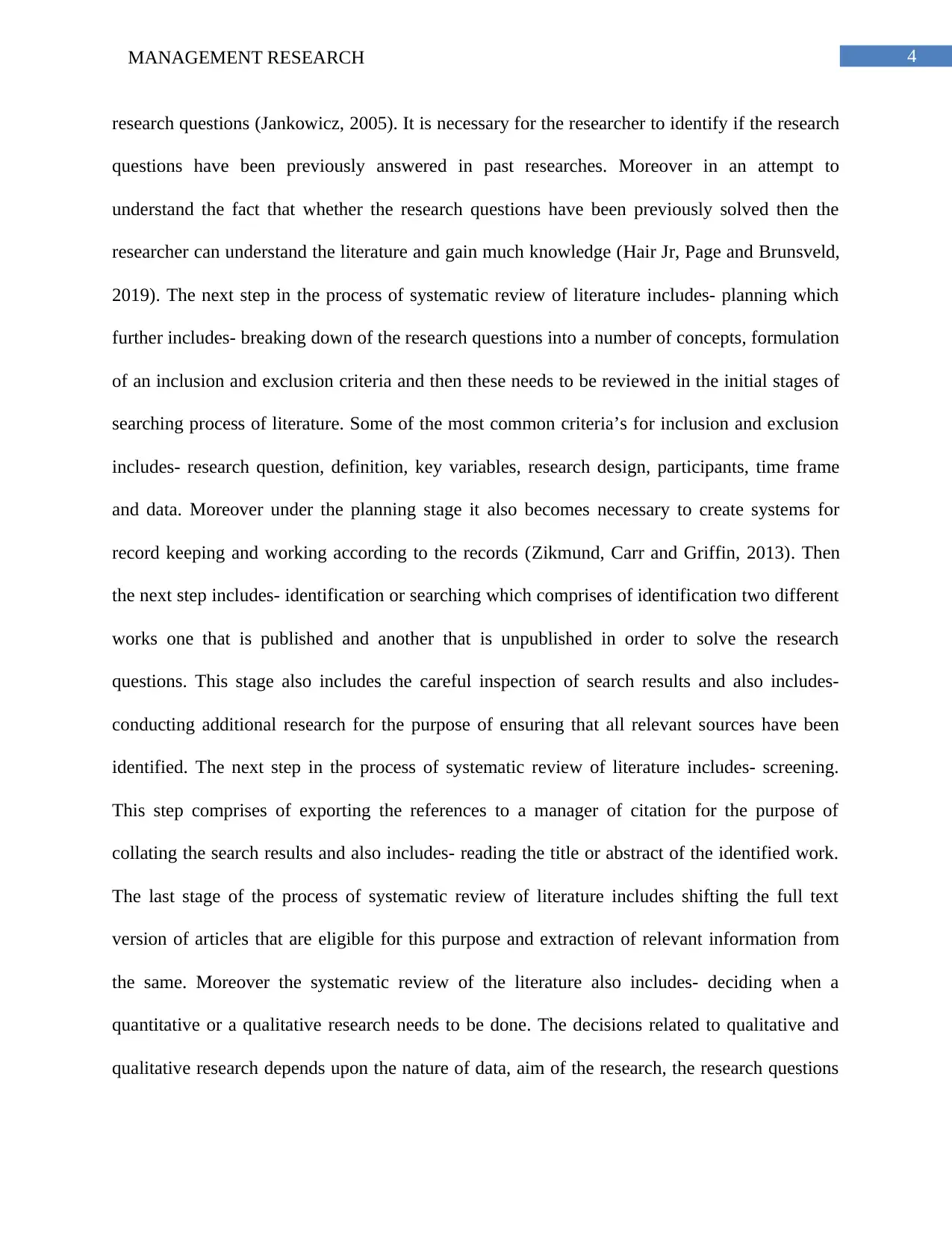
4MANAGEMENT RESEARCH
research questions (Jankowicz, 2005). It is necessary for the researcher to identify if the research
questions have been previously answered in past researches. Moreover in an attempt to
understand the fact that whether the research questions have been previously solved then the
researcher can understand the literature and gain much knowledge (Hair Jr, Page and Brunsveld,
2019). The next step in the process of systematic review of literature includes- planning which
further includes- breaking down of the research questions into a number of concepts, formulation
of an inclusion and exclusion criteria and then these needs to be reviewed in the initial stages of
searching process of literature. Some of the most common criteria’s for inclusion and exclusion
includes- research question, definition, key variables, research design, participants, time frame
and data. Moreover under the planning stage it also becomes necessary to create systems for
record keeping and working according to the records (Zikmund, Carr and Griffin, 2013). Then
the next step includes- identification or searching which comprises of identification two different
works one that is published and another that is unpublished in order to solve the research
questions. This stage also includes the careful inspection of search results and also includes-
conducting additional research for the purpose of ensuring that all relevant sources have been
identified. The next step in the process of systematic review of literature includes- screening.
This step comprises of exporting the references to a manager of citation for the purpose of
collating the search results and also includes- reading the title or abstract of the identified work.
The last stage of the process of systematic review of literature includes shifting the full text
version of articles that are eligible for this purpose and extraction of relevant information from
the same. Moreover the systematic review of the literature also includes- deciding when a
quantitative or a qualitative research needs to be done. The decisions related to qualitative and
qualitative research depends upon the nature of data, aim of the research, the research questions
research questions (Jankowicz, 2005). It is necessary for the researcher to identify if the research
questions have been previously answered in past researches. Moreover in an attempt to
understand the fact that whether the research questions have been previously solved then the
researcher can understand the literature and gain much knowledge (Hair Jr, Page and Brunsveld,
2019). The next step in the process of systematic review of literature includes- planning which
further includes- breaking down of the research questions into a number of concepts, formulation
of an inclusion and exclusion criteria and then these needs to be reviewed in the initial stages of
searching process of literature. Some of the most common criteria’s for inclusion and exclusion
includes- research question, definition, key variables, research design, participants, time frame
and data. Moreover under the planning stage it also becomes necessary to create systems for
record keeping and working according to the records (Zikmund, Carr and Griffin, 2013). Then
the next step includes- identification or searching which comprises of identification two different
works one that is published and another that is unpublished in order to solve the research
questions. This stage also includes the careful inspection of search results and also includes-
conducting additional research for the purpose of ensuring that all relevant sources have been
identified. The next step in the process of systematic review of literature includes- screening.
This step comprises of exporting the references to a manager of citation for the purpose of
collating the search results and also includes- reading the title or abstract of the identified work.
The last stage of the process of systematic review of literature includes shifting the full text
version of articles that are eligible for this purpose and extraction of relevant information from
the same. Moreover the systematic review of the literature also includes- deciding when a
quantitative or a qualitative research needs to be done. The decisions related to qualitative and
qualitative research depends upon the nature of data, aim of the research, the research questions
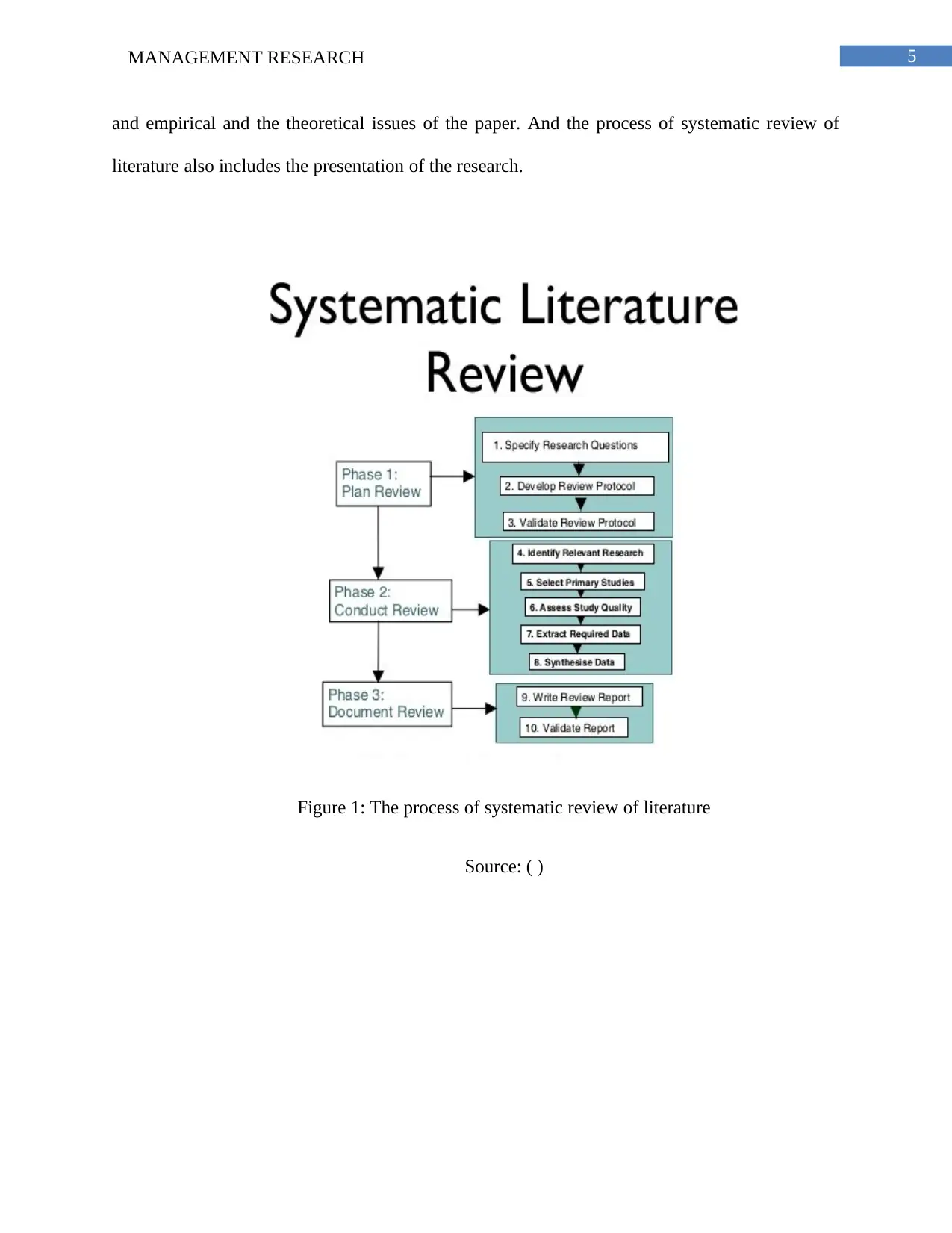
5MANAGEMENT RESEARCH
and empirical and the theoretical issues of the paper. And the process of systematic review of
literature also includes the presentation of the research.
Figure 1: The process of systematic review of literature
Source: ( )
and empirical and the theoretical issues of the paper. And the process of systematic review of
literature also includes the presentation of the research.
Figure 1: The process of systematic review of literature
Source: ( )
⊘ This is a preview!⊘
Do you want full access?
Subscribe today to unlock all pages.

Trusted by 1+ million students worldwide
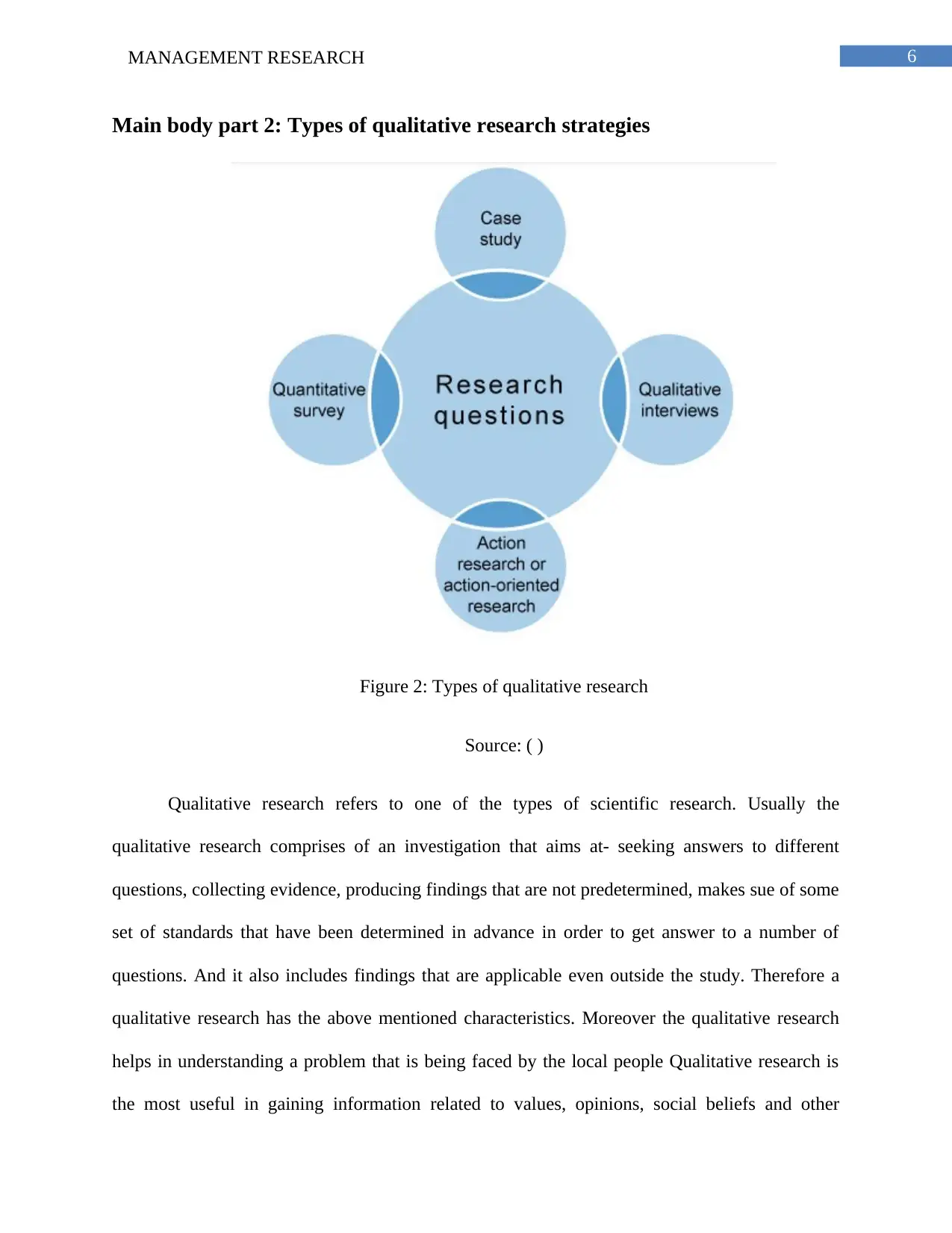
6MANAGEMENT RESEARCH
Main body part 2: Types of qualitative research strategies
Figure 2: Types of qualitative research
Source: ( )
Qualitative research refers to one of the types of scientific research. Usually the
qualitative research comprises of an investigation that aims at- seeking answers to different
questions, collecting evidence, producing findings that are not predetermined, makes sue of some
set of standards that have been determined in advance in order to get answer to a number of
questions. And it also includes findings that are applicable even outside the study. Therefore a
qualitative research has the above mentioned characteristics. Moreover the qualitative research
helps in understanding a problem that is being faced by the local people Qualitative research is
the most useful in gaining information related to values, opinions, social beliefs and other
Main body part 2: Types of qualitative research strategies
Figure 2: Types of qualitative research
Source: ( )
Qualitative research refers to one of the types of scientific research. Usually the
qualitative research comprises of an investigation that aims at- seeking answers to different
questions, collecting evidence, producing findings that are not predetermined, makes sue of some
set of standards that have been determined in advance in order to get answer to a number of
questions. And it also includes findings that are applicable even outside the study. Therefore a
qualitative research has the above mentioned characteristics. Moreover the qualitative research
helps in understanding a problem that is being faced by the local people Qualitative research is
the most useful in gaining information related to values, opinions, social beliefs and other
Paraphrase This Document
Need a fresh take? Get an instant paraphrase of this document with our AI Paraphraser
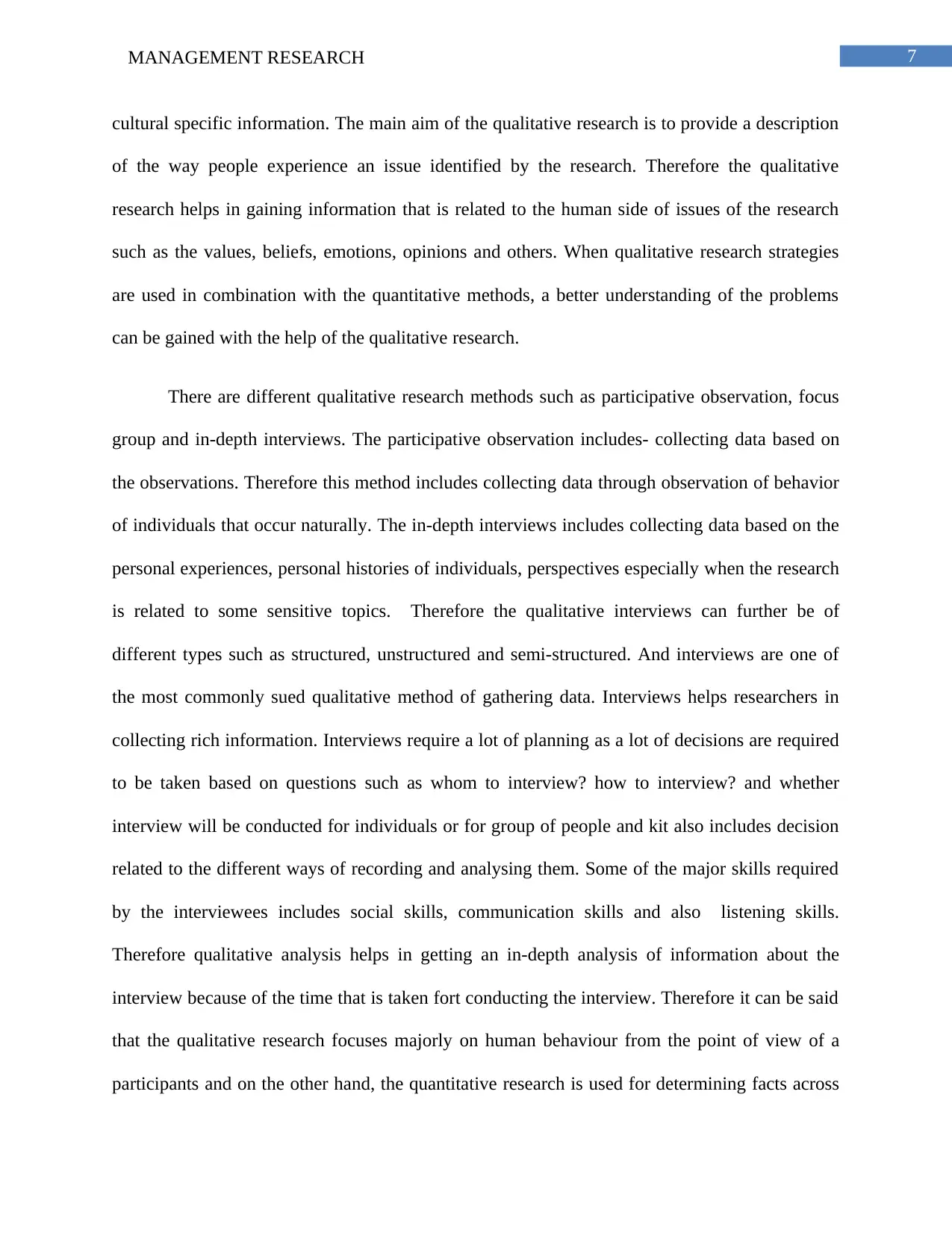
7MANAGEMENT RESEARCH
cultural specific information. The main aim of the qualitative research is to provide a description
of the way people experience an issue identified by the research. Therefore the qualitative
research helps in gaining information that is related to the human side of issues of the research
such as the values, beliefs, emotions, opinions and others. When qualitative research strategies
are used in combination with the quantitative methods, a better understanding of the problems
can be gained with the help of the qualitative research.
There are different qualitative research methods such as participative observation, focus
group and in-depth interviews. The participative observation includes- collecting data based on
the observations. Therefore this method includes collecting data through observation of behavior
of individuals that occur naturally. The in-depth interviews includes collecting data based on the
personal experiences, personal histories of individuals, perspectives especially when the research
is related to some sensitive topics. Therefore the qualitative interviews can further be of
different types such as structured, unstructured and semi-structured. And interviews are one of
the most commonly sued qualitative method of gathering data. Interviews helps researchers in
collecting rich information. Interviews require a lot of planning as a lot of decisions are required
to be taken based on questions such as whom to interview? how to interview? and whether
interview will be conducted for individuals or for group of people and kit also includes decision
related to the different ways of recording and analysing them. Some of the major skills required
by the interviewees includes social skills, communication skills and also listening skills.
Therefore qualitative analysis helps in getting an in-depth analysis of information about the
interview because of the time that is taken fort conducting the interview. Therefore it can be said
that the qualitative research focuses majorly on human behaviour from the point of view of a
participants and on the other hand, the quantitative research is used for determining facts across
cultural specific information. The main aim of the qualitative research is to provide a description
of the way people experience an issue identified by the research. Therefore the qualitative
research helps in gaining information that is related to the human side of issues of the research
such as the values, beliefs, emotions, opinions and others. When qualitative research strategies
are used in combination with the quantitative methods, a better understanding of the problems
can be gained with the help of the qualitative research.
There are different qualitative research methods such as participative observation, focus
group and in-depth interviews. The participative observation includes- collecting data based on
the observations. Therefore this method includes collecting data through observation of behavior
of individuals that occur naturally. The in-depth interviews includes collecting data based on the
personal experiences, personal histories of individuals, perspectives especially when the research
is related to some sensitive topics. Therefore the qualitative interviews can further be of
different types such as structured, unstructured and semi-structured. And interviews are one of
the most commonly sued qualitative method of gathering data. Interviews helps researchers in
collecting rich information. Interviews require a lot of planning as a lot of decisions are required
to be taken based on questions such as whom to interview? how to interview? and whether
interview will be conducted for individuals or for group of people and kit also includes decision
related to the different ways of recording and analysing them. Some of the major skills required
by the interviewees includes social skills, communication skills and also listening skills.
Therefore qualitative analysis helps in getting an in-depth analysis of information about the
interview because of the time that is taken fort conducting the interview. Therefore it can be said
that the qualitative research focuses majorly on human behaviour from the point of view of a
participants and on the other hand, the quantitative research is used for determining facts across
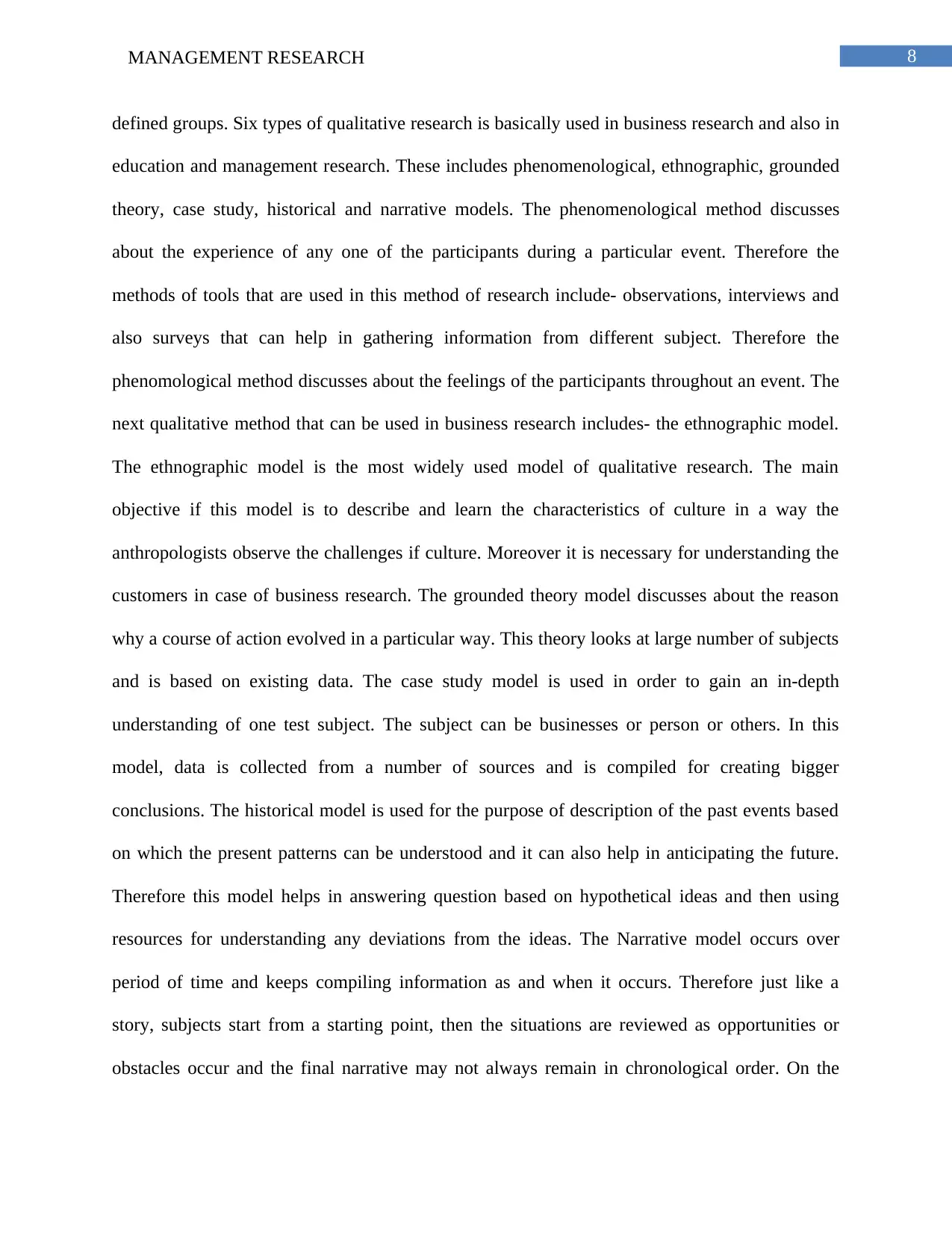
8MANAGEMENT RESEARCH
defined groups. Six types of qualitative research is basically used in business research and also in
education and management research. These includes phenomenological, ethnographic, grounded
theory, case study, historical and narrative models. The phenomenological method discusses
about the experience of any one of the participants during a particular event. Therefore the
methods of tools that are used in this method of research include- observations, interviews and
also surveys that can help in gathering information from different subject. Therefore the
phenomological method discusses about the feelings of the participants throughout an event. The
next qualitative method that can be used in business research includes- the ethnographic model.
The ethnographic model is the most widely used model of qualitative research. The main
objective if this model is to describe and learn the characteristics of culture in a way the
anthropologists observe the challenges if culture. Moreover it is necessary for understanding the
customers in case of business research. The grounded theory model discusses about the reason
why a course of action evolved in a particular way. This theory looks at large number of subjects
and is based on existing data. The case study model is used in order to gain an in-depth
understanding of one test subject. The subject can be businesses or person or others. In this
model, data is collected from a number of sources and is compiled for creating bigger
conclusions. The historical model is used for the purpose of description of the past events based
on which the present patterns can be understood and it can also help in anticipating the future.
Therefore this model helps in answering question based on hypothetical ideas and then using
resources for understanding any deviations from the ideas. The Narrative model occurs over
period of time and keeps compiling information as and when it occurs. Therefore just like a
story, subjects start from a starting point, then the situations are reviewed as opportunities or
obstacles occur and the final narrative may not always remain in chronological order. On the
defined groups. Six types of qualitative research is basically used in business research and also in
education and management research. These includes phenomenological, ethnographic, grounded
theory, case study, historical and narrative models. The phenomenological method discusses
about the experience of any one of the participants during a particular event. Therefore the
methods of tools that are used in this method of research include- observations, interviews and
also surveys that can help in gathering information from different subject. Therefore the
phenomological method discusses about the feelings of the participants throughout an event. The
next qualitative method that can be used in business research includes- the ethnographic model.
The ethnographic model is the most widely used model of qualitative research. The main
objective if this model is to describe and learn the characteristics of culture in a way the
anthropologists observe the challenges if culture. Moreover it is necessary for understanding the
customers in case of business research. The grounded theory model discusses about the reason
why a course of action evolved in a particular way. This theory looks at large number of subjects
and is based on existing data. The case study model is used in order to gain an in-depth
understanding of one test subject. The subject can be businesses or person or others. In this
model, data is collected from a number of sources and is compiled for creating bigger
conclusions. The historical model is used for the purpose of description of the past events based
on which the present patterns can be understood and it can also help in anticipating the future.
Therefore this model helps in answering question based on hypothetical ideas and then using
resources for understanding any deviations from the ideas. The Narrative model occurs over
period of time and keeps compiling information as and when it occurs. Therefore just like a
story, subjects start from a starting point, then the situations are reviewed as opportunities or
obstacles occur and the final narrative may not always remain in chronological order. On the
⊘ This is a preview!⊘
Do you want full access?
Subscribe today to unlock all pages.

Trusted by 1+ million students worldwide
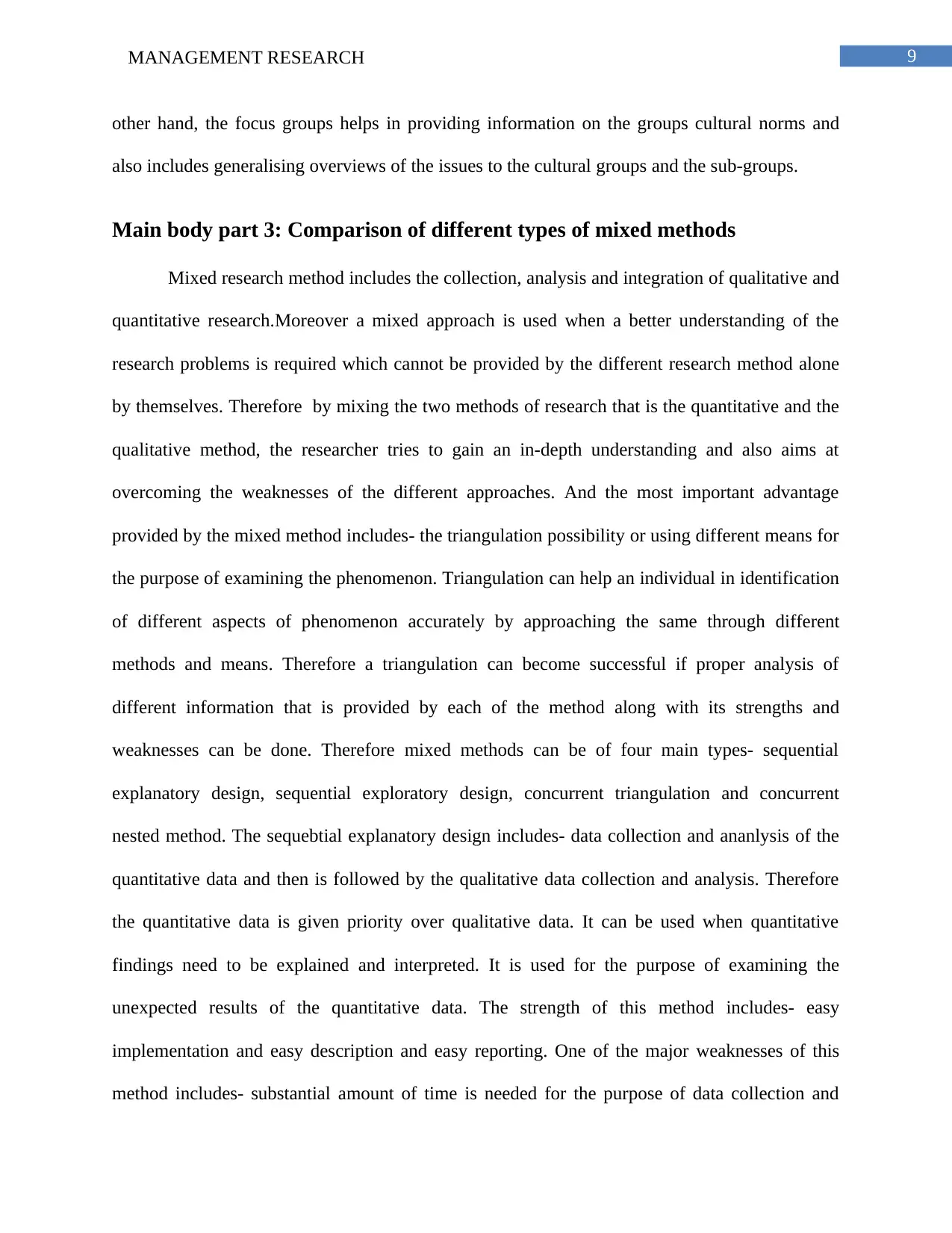
9MANAGEMENT RESEARCH
other hand, the focus groups helps in providing information on the groups cultural norms and
also includes generalising overviews of the issues to the cultural groups and the sub-groups.
Main body part 3: Comparison of different types of mixed methods
Mixed research method includes the collection, analysis and integration of qualitative and
quantitative research.Moreover a mixed approach is used when a better understanding of the
research problems is required which cannot be provided by the different research method alone
by themselves. Therefore by mixing the two methods of research that is the quantitative and the
qualitative method, the researcher tries to gain an in-depth understanding and also aims at
overcoming the weaknesses of the different approaches. And the most important advantage
provided by the mixed method includes- the triangulation possibility or using different means for
the purpose of examining the phenomenon. Triangulation can help an individual in identification
of different aspects of phenomenon accurately by approaching the same through different
methods and means. Therefore a triangulation can become successful if proper analysis of
different information that is provided by each of the method along with its strengths and
weaknesses can be done. Therefore mixed methods can be of four main types- sequential
explanatory design, sequential exploratory design, concurrent triangulation and concurrent
nested method. The sequebtial explanatory design includes- data collection and ananlysis of the
quantitative data and then is followed by the qualitative data collection and analysis. Therefore
the quantitative data is given priority over qualitative data. It can be used when quantitative
findings need to be explained and interpreted. It is used for the purpose of examining the
unexpected results of the quantitative data. The strength of this method includes- easy
implementation and easy description and easy reporting. One of the major weaknesses of this
method includes- substantial amount of time is needed for the purpose of data collection and
other hand, the focus groups helps in providing information on the groups cultural norms and
also includes generalising overviews of the issues to the cultural groups and the sub-groups.
Main body part 3: Comparison of different types of mixed methods
Mixed research method includes the collection, analysis and integration of qualitative and
quantitative research.Moreover a mixed approach is used when a better understanding of the
research problems is required which cannot be provided by the different research method alone
by themselves. Therefore by mixing the two methods of research that is the quantitative and the
qualitative method, the researcher tries to gain an in-depth understanding and also aims at
overcoming the weaknesses of the different approaches. And the most important advantage
provided by the mixed method includes- the triangulation possibility or using different means for
the purpose of examining the phenomenon. Triangulation can help an individual in identification
of different aspects of phenomenon accurately by approaching the same through different
methods and means. Therefore a triangulation can become successful if proper analysis of
different information that is provided by each of the method along with its strengths and
weaknesses can be done. Therefore mixed methods can be of four main types- sequential
explanatory design, sequential exploratory design, concurrent triangulation and concurrent
nested method. The sequebtial explanatory design includes- data collection and ananlysis of the
quantitative data and then is followed by the qualitative data collection and analysis. Therefore
the quantitative data is given priority over qualitative data. It can be used when quantitative
findings need to be explained and interpreted. It is used for the purpose of examining the
unexpected results of the quantitative data. The strength of this method includes- easy
implementation and easy description and easy reporting. One of the major weaknesses of this
method includes- substantial amount of time is needed for the purpose of data collection and
Paraphrase This Document
Need a fresh take? Get an instant paraphrase of this document with our AI Paraphraser
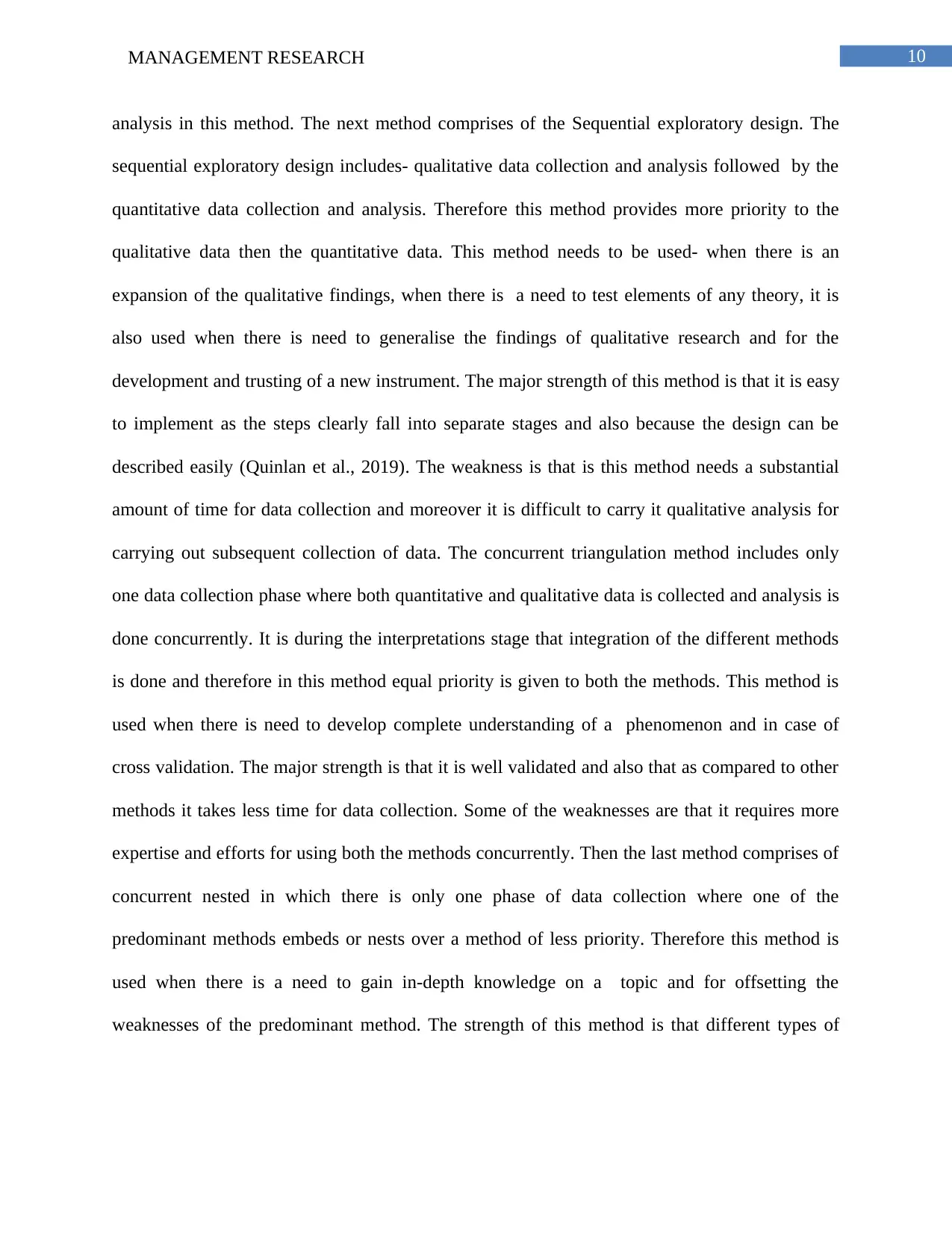
10MANAGEMENT RESEARCH
analysis in this method. The next method comprises of the Sequential exploratory design. The
sequential exploratory design includes- qualitative data collection and analysis followed by the
quantitative data collection and analysis. Therefore this method provides more priority to the
qualitative data then the quantitative data. This method needs to be used- when there is an
expansion of the qualitative findings, when there is a need to test elements of any theory, it is
also used when there is need to generalise the findings of qualitative research and for the
development and trusting of a new instrument. The major strength of this method is that it is easy
to implement as the steps clearly fall into separate stages and also because the design can be
described easily (Quinlan et al., 2019). The weakness is that is this method needs a substantial
amount of time for data collection and moreover it is difficult to carry it qualitative analysis for
carrying out subsequent collection of data. The concurrent triangulation method includes only
one data collection phase where both quantitative and qualitative data is collected and analysis is
done concurrently. It is during the interpretations stage that integration of the different methods
is done and therefore in this method equal priority is given to both the methods. This method is
used when there is need to develop complete understanding of a phenomenon and in case of
cross validation. The major strength is that it is well validated and also that as compared to other
methods it takes less time for data collection. Some of the weaknesses are that it requires more
expertise and efforts for using both the methods concurrently. Then the last method comprises of
concurrent nested in which there is only one phase of data collection where one of the
predominant methods embeds or nests over a method of less priority. Therefore this method is
used when there is a need to gain in-depth knowledge on a topic and for offsetting the
weaknesses of the predominant method. The strength of this method is that different types of
analysis in this method. The next method comprises of the Sequential exploratory design. The
sequential exploratory design includes- qualitative data collection and analysis followed by the
quantitative data collection and analysis. Therefore this method provides more priority to the
qualitative data then the quantitative data. This method needs to be used- when there is an
expansion of the qualitative findings, when there is a need to test elements of any theory, it is
also used when there is need to generalise the findings of qualitative research and for the
development and trusting of a new instrument. The major strength of this method is that it is easy
to implement as the steps clearly fall into separate stages and also because the design can be
described easily (Quinlan et al., 2019). The weakness is that is this method needs a substantial
amount of time for data collection and moreover it is difficult to carry it qualitative analysis for
carrying out subsequent collection of data. The concurrent triangulation method includes only
one data collection phase where both quantitative and qualitative data is collected and analysis is
done concurrently. It is during the interpretations stage that integration of the different methods
is done and therefore in this method equal priority is given to both the methods. This method is
used when there is need to develop complete understanding of a phenomenon and in case of
cross validation. The major strength is that it is well validated and also that as compared to other
methods it takes less time for data collection. Some of the weaknesses are that it requires more
expertise and efforts for using both the methods concurrently. Then the last method comprises of
concurrent nested in which there is only one phase of data collection where one of the
predominant methods embeds or nests over a method of less priority. Therefore this method is
used when there is a need to gain in-depth knowledge on a topic and for offsetting the
weaknesses of the predominant method. The strength of this method is that different types of
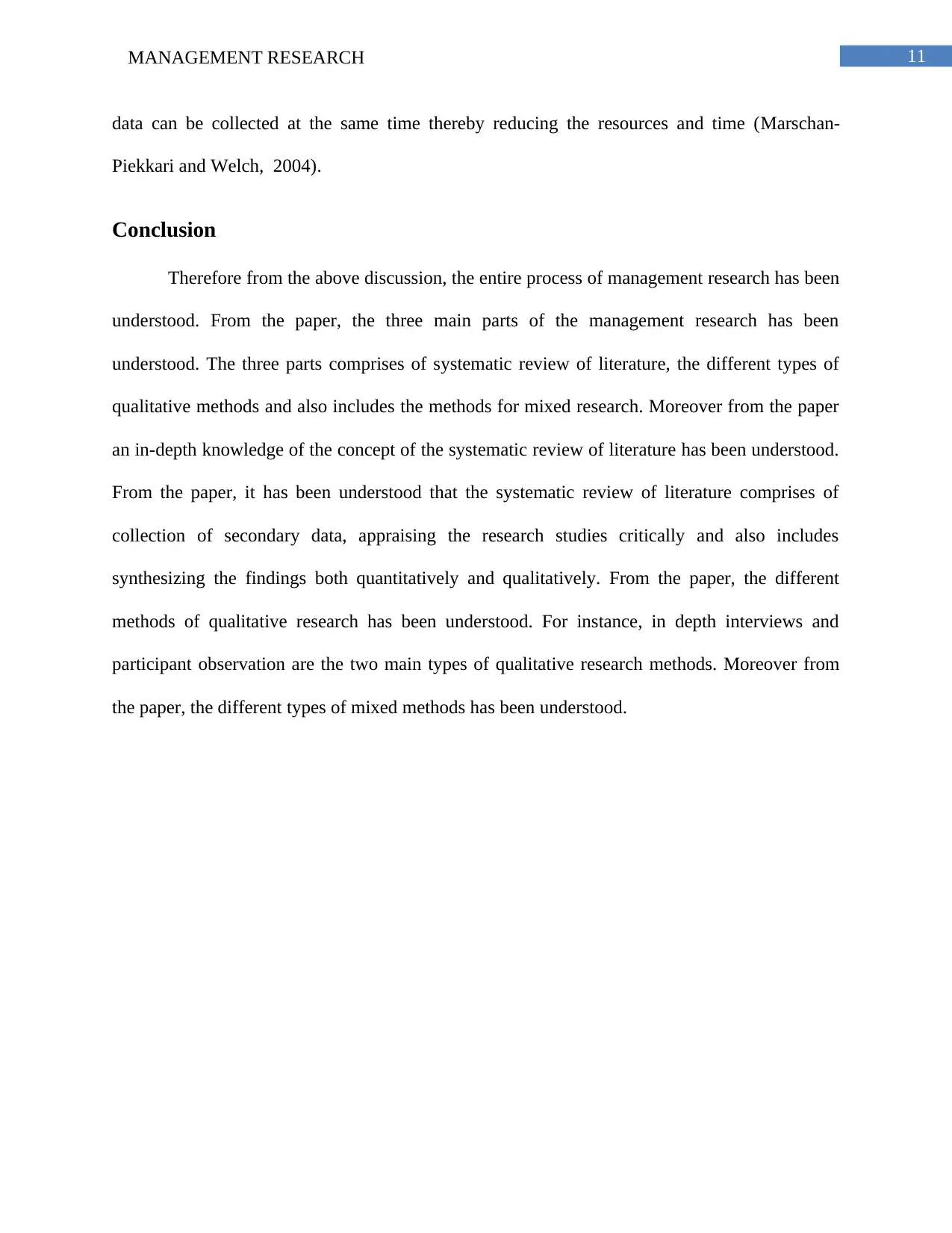
11MANAGEMENT RESEARCH
data can be collected at the same time thereby reducing the resources and time (Marschan-
Piekkari and Welch, 2004).
Conclusion
Therefore from the above discussion, the entire process of management research has been
understood. From the paper, the three main parts of the management research has been
understood. The three parts comprises of systematic review of literature, the different types of
qualitative methods and also includes the methods for mixed research. Moreover from the paper
an in-depth knowledge of the concept of the systematic review of literature has been understood.
From the paper, it has been understood that the systematic review of literature comprises of
collection of secondary data, appraising the research studies critically and also includes
synthesizing the findings both quantitatively and qualitatively. From the paper, the different
methods of qualitative research has been understood. For instance, in depth interviews and
participant observation are the two main types of qualitative research methods. Moreover from
the paper, the different types of mixed methods has been understood.
data can be collected at the same time thereby reducing the resources and time (Marschan-
Piekkari and Welch, 2004).
Conclusion
Therefore from the above discussion, the entire process of management research has been
understood. From the paper, the three main parts of the management research has been
understood. The three parts comprises of systematic review of literature, the different types of
qualitative methods and also includes the methods for mixed research. Moreover from the paper
an in-depth knowledge of the concept of the systematic review of literature has been understood.
From the paper, it has been understood that the systematic review of literature comprises of
collection of secondary data, appraising the research studies critically and also includes
synthesizing the findings both quantitatively and qualitatively. From the paper, the different
methods of qualitative research has been understood. For instance, in depth interviews and
participant observation are the two main types of qualitative research methods. Moreover from
the paper, the different types of mixed methods has been understood.
⊘ This is a preview!⊘
Do you want full access?
Subscribe today to unlock all pages.

Trusted by 1+ million students worldwide
1 out of 13
Related Documents
Your All-in-One AI-Powered Toolkit for Academic Success.
+13062052269
info@desklib.com
Available 24*7 on WhatsApp / Email
![[object Object]](/_next/static/media/star-bottom.7253800d.svg)
Unlock your academic potential
Copyright © 2020–2025 A2Z Services. All Rights Reserved. Developed and managed by ZUCOL.





